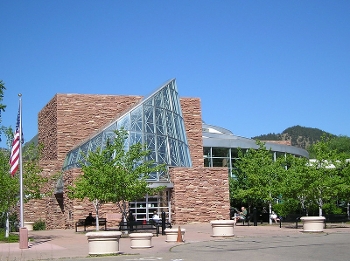Colorado Libraries Contend with a String of Meth Contaminations
In recent months, four public libraries in Colorado's Front Range region have been forced to contend with methamphetamine residue, and the subsequent remediation, in bathrooms and public spaces.
 |
Boulder Public Library Main branchPhoto by Butal Lee via flickr |
On September 15, 2022, a patron at the Main Boulder Public Library, CO, approached staff with a complaint: There were smoke fumes coming out of the men’s restroom on the second floor. Two security guards walked in to check the space and reported feeling dizzy and light-headed when they exited. “We called the police and they checked the restroom, but they didn’t find any drug use [in progress] to know exactly what we were dealing with,” said Boulder Public Library Communications Program Manager Annie Elliott.
As autumn progressed, however, complaints started to crop up from both patrons and staff about a “chemical-y” smell accompanied by an uptick of incident reports that centered around men's restrooms. Though the library tried to coordinate an environmental testing company to inspect the premises in early December 2022, a lack of statewide providers caused a delay until December 13. The situation reached a breaking point on December 15, 2022, when staff members contacted police and the fire department about fumes coming from the restroom. An accompanying Hazmat team found burnt foil inside. BPL received notice on December 20 that their test results were in.
Of the 99 wipe samples taken, including blanks as a control group, 14 showed high contamination levels of methamphetamine concentrated in the public-facing restrooms. Additional areas with high exposure levels were computers, keyboards, and seating areas. The library closed for remediation on December 20, 2022.
In Englewood, CO, 35 miles south of Boulder, city officials across a range of city departments had noticed an increase in drug use in the immediate vicinity of the Englewood Public Library. Library staff and patrons alike reported that there was a chemical-based smell emanating from the public bathrooms. Once the news of Boulder’s experience broke, Englewood officials realized that the problem could be meth or fentanyl contamination, prompting Englewood Public Library to test for drug residue.
“After Boulder, we decided to test and hoped [that] wasn’t going to be the results we received,” noted Christina Underhill, director of Parks, Recreation, Library and Golf for the City of Englewood. The library closed on January 11 within an hour or two of receiving high-contamination test results for methamphetamine. The highest concentrations were also in the public-facing restrooms.
The impacted libraries of Colorado’s Front Range region don’t end there. Bemis Public Library in Littleton, CO, closed on January 18 after discovering methamphetamine contamination in the first floor public bathrooms. Bemis tested the library out of “an abundance of caution,” according to a January 18 press release, after the findings in Boulder and Englewood became public. The Arvada–Jefferson County Public Library also closed due to meth contamination on January 29.
While it might appear that there is some connection between the contaminated Colorado libraries, Elliott and Underhill are certain that there are no individuals who might be responsible: The contaminations are a symptom of a wider, regional problem. “Unfortunately, in Boulder [meth use] is nothing new,” Elliott said.
And even if a person uses methamphetamine outdoors, contamination lingers. “It’s going to be on their skin, their clothing. If [they] handle a dollar, there could be meth residue on it,” explained Elliott. “[This] opened my eyes to all of the exposure that someone could have.”
Even so, there are still questions about how long meth contamination naturally lasts. In the Englewood Public Library, third-floor restrooms are staff-only and require badge access to enter. They were tested out of an abundance of caution and came back positive for meth contamination. “Those have been closed to the public for three years. We’re worried that the public used those restrooms for drugs years ago,” said Underhill.
According to Underhill, those restrooms tend to be frequently used by staff members. The city has the authority to drug test an employee if there is a reasonable suspicion that they’re impaired. Thus, Underhill felt that it was unlikely that a staff member could have used drugs without getting reported. “We asked [testing officials] and they said [that meth residue] can linger for up to 10 years,” she said.
REMEDIATION EFFORTS
Boulder Public Library spent $50,000 on initial testing and an additional $50,000 on remediation. The remediation process included ripping out booths, disposing furniture, replacing seating fabrics, and other specialized cleanings. As of January 31, Boulder received a contract to remediate the bathrooms, which will cost around $68,000.
In Englewood, Underhill is still figuring out the final cost of remediation, which began on January 30, but the initial quotes are between $38,000 and $45,000 for the necessary cleanings. “[We have] tiles on the walls, so it’s going to be a deep clean on the tile,” Underhill noted. “We could be reopening sooner than anticipated” Once complete, various spaces will be retested to examine if contamination is below the necessary threshold. The remediation process should last 15 to 30 days, and the library will reopen within 48 hours of receiving acceptable test results.
In remediation efforts, there are different approaches to high and standard levels of contamination. High levels of contamination that are over 0.5 micrograms per square centimeter require disposing of all impacted porous surfaces—there is no saving them. Standard levels of contamination below that 0.5 microgram threshold require areas to be cleaned, swabbed, and tested again to ensure that contamination levels have gone down.
While Boulder had computer replacements in their budget for this year, meth contamination on computers and keyboards forced the library to replace them earlier than expected. “Currently, we have no computers at our Main Library. We’re going several months without them until the fall when we can get control over the situation and make sure things are safe,” said Elliott.
Boulder reopened on January 9, though a substantial portion of the public restrooms are blocked off and sealed. Moving forward, restroom access will be controlled by staff and security. “Unfortunately, that’s what we’ll have to do to keep control over the situation,” said Elliott.
Pre-pandemic, the Boulder Public Library system received over a million visits annually across its five branches. Visits have not reached those levels again, and staff levels have been cut. As a result, the remaining employees have difficulty keeping an eye on eight sets of restrooms across multiple wings and two floors. Even with recent trainings on how to supervise larger swaths of the 55,000 square foot library, this is a challenge.
In Englewood, some of the strategies to curb drug use include increased security and smoke detection systems in the public bathrooms. In 2022, the library issued standards of behavior for patrons, and is looking to improve them in 2023 to ensure that public spaces are not abused.
Both Boulder and Englewood acknowledge that even if a patron was caught in the act of smoking meth in the libraries, there is little that can legally be done. “If someone consumes drugs but has no paraphernalia or drugs [on them], the police can’t arrest someone just because they’re high,” explained Elliott. “Our hands get tied. We might have the same person that smoked in the morning in the bathroom [come] back in the afternoon.”
Underhill concurred. “There’s a lot of factors, but it’s all [coming from] the same direction: increased use, increased availability of drugs, and decriminalization of drug use. We asked the police [what to do] if we caught someone using drugs in the restroom, and they said all [they] can do is take people in and release [them], whether it’s public spaces or indoors.” The only time that an individual can be punished for being caught using drugs is if they have prior crimes on their record or commit additional crimes while using drugs. Otherwise, they are ticketed and released.
Both Boulder and Englewood are focused on creating welcoming spaces for all members of the public and staff alike. “Whether [a patron] is coming in for story time or a warming shelter, moving forward, we want libraries to be a good space for everybody,” said Underhill. However, the recent incidents of methamphetamine contamination have been disruptive and expensive. For Boulder, there is a slight sense of relief that the cause of contamination has finally been identified, but the price for clean-up is a serious hindrance. “If we had to go through this again, we aren’t sure where we would get the money to make all the improvements,” said Elliott. “We have to complete the remediation as required by the state after testing.”
For Englewood, the situation has helped bind together regional libraries to identify best practices on drug contamination moving forward. But Underhill is cognizant that the situation has impacted the community’s perception of the library. “A few patrons had expressed they didn’t feel safe coming to the library,” she said. “I believe that being proactive with the meth testing and remediation has helped. With some of the [policy] changes [we’re making], I think people will feel more confident and be willing to return.”
What a sad, awful situation that is difficult for staff, patrons and law enforcement. We're facing increased drug use in my library system, too. Not great to hear that the residue from drug use can still be present YEARS after the actual drug use.
Add Comment :-
RELATED
ALREADY A SUBSCRIBER? LOG IN
We are currently offering this content for free. Sign up now to activate your personal profile, where you can save articles for future viewing









